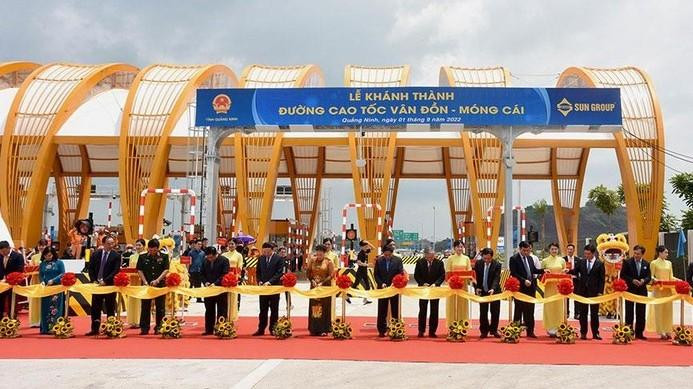The expressway, which is 80.23km long and 25.25m wide, connects Van Don International Airport and the access road to Bac Luan 2 Bridge on the Vietnam - China border in Mong Cai city. Built in just over two years since the completion of site clearance, it has four lanes for vehicles, two emergency lanes, and a design speed of 120km per hour, which is also the maximum design speed for expressways in Vietnam.
The road is equipped with an intelligent transport system working around the clock and in all weather conditions.
Besides, it is one of the roads featuring the most sea and river bridges in the country, with 35 bridges totalling more than 7.9km on the main route – equivalent to 10% of its length.
Chairman of the Quang Ninh People’s Committee Nguyen Tuong Van said Van Don - Mong Cai Expressway helps shorten the travel time from Hanoi to Mong Cai city to three hours.
It is also connected with the expressway traversing Van Don, Ha Long, Hai Phong, Hanoi, and Lao Cai, forming the country’s longest expressway – nearly 600km. This has turn Quang Ninh into the locality boasting the greatest expressway length – 176km.
In addition, Van Don - Mong Cai is the first of its kind to link three airports (Noi Bai in Hanoi, Cat Bi in Hai Phong, and Van Don), and three economic zones with one international border gate. It also helps link other ASEAN countries and Vietnamese localities with China via the Mong Cai International Border Gate, thereby facilitating investment attraction, border economic activities, as well as social and tourism development in the province, Van noted.
Addressing the inauguration ceremony held in coordination with Sun Group, Prime Minister Pham Minh Chinh said Van Don - Mong Cai Expressway is the last part of the road axis running through Quang Ninh with total length of 176km, accounting for 16.8% of the combined expressway length in Vietnam.
He held that Van Don - Mong Cai Expressway will help Quang Ninh establish itself as a strategic transit point in the East Asia - Southeast Asia - ASEAN - China region, the “Two Corridors, One Belt” cooperation zone between Vietnam and China, and the expanded Gulf of Tonkin inter-regional cooperation area under the ASEAN - China Free Trade Area, thus creating a strong impulse for connectivity in the northern key economic region and the Red River Delta of Vietnam.
This artery is also part of efforts to carry out the Party and State’s policy on developing transport infrastructure, particularly the expressway system, to help remove transport bottlenecks, he went on.
Noting that it was invested with 44 trillion VND (1.87 billion USD), 15.6 trillion VND of which (35.5%) was funded by the local budget and the remaining 28.2 trillion VND (64.5%) by private businesses, the PM described the road as a successful example of the public - private partnership in infrastructure development.
The Government leader said it will not only create a new development space for the northern midland and mountainous region and the Red River Delta, including Quang Ninh, but also promote production, business, trading, service, tourism, industrial, and urban development in the places it traverses.
He urged Quang Ninh to quickly complete procedures for the expressway management while localities should coordinate with one another to make the best use of the road to serve socio-economic development and achieve green, fast, and sustainable development.
















